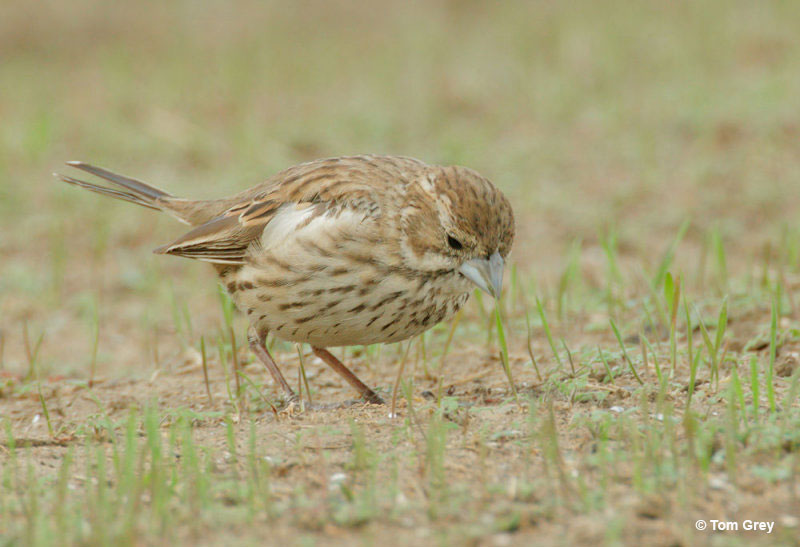
The state bird of Colorado is the Lark Bunting. Colorado is the eighth largest state in the USA and is located in the central-western part of the country. This beautiful and scenic state is dominated by the Rocky Mountains but also features sagebrush habitats, wide-open plains, and lakes and wetlands dotted with flocks of ducks and pelicans.
In spring, flocks of this sparrow-sized species accentuate prairies and other open habitats with their bounding flight and bold white wing patches. As the small birds set up nesting territories, male Lark Buntings full the prairie air with a complex song that includes tinkling, trilling, and warbling phrases.
Even better, the boldly patterned, black and white males fly high above a post or other perch to belt out their songs. The spectacle is as beautiful and uplifting as it is hard to miss, and is one of the reasons why this unique species was chosen to be the state bird of Colorado.
On this page
History
The Lark Bunting became the official state bird of Colorado on April 29, 1931.
This small and seemingly average bird was not the first choice for the state bird of Colorado but won the spot after lobbying and marketing by the bird’s biggest fan, Roy Langdon.
Roy was an educator in Fort Collins and the president of the main birding organization in Colorado at that time, the Colorado Audubon Society. After the first state bird was chosen by Kentucky in 1926, Mr. Langdon began to lobby for the Lark Bunting being proclaimed the official state bird for Colorado.
He wrote several articles and publications in support of his position including one called, “Seventeen Reasons Why the Lark Bunting Should be Colorado’s State Bird”.
In this and other publications, Langdon argued that even though prairie ecosystems dominated eastern Colorado, animals and plants from the mountains dominated other official symbols for the state. He believed it was about time that the state chose a symbol representative of eastern Colorado, especially because that was where most of the state’s agricultural interests were located.
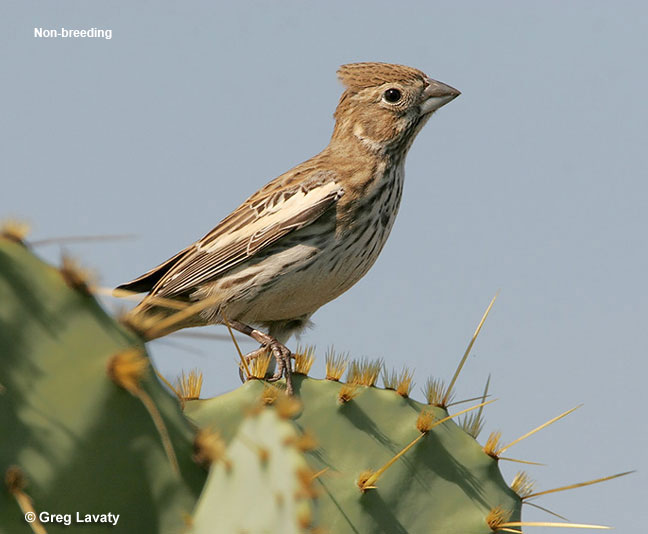
Roy was steadfast in his support for the Lark Bunting, even mentioning that the black and white colors of the male were the colors best suited for trademark and letterhead associated with the state.
By April, 1931, his determination and arguments had paid off although another of the main reasons why the Lark Bunting was chosen was because the other main candidates, the Western Meadowlark and the Mountain Bluebird, had already been chosen as official birds by other states.
No state had even considered the Lark Bunting and so it became one of the more unique birds chosen for a state.
Facts about The Colorado State Bird
- Despite its name, the Lark Bunting is not closely related to buntings in Europe nor the buntings in North America. It is one of the New World Sparrows, a family that includes the Song Sparrow, Chipping Sparrow, and towhees.
- A flocking bird. Lark Buntings form pairs during the breeding season but, for most of the year, this bird species forms flocks that can number in the thousands. During migration and winter, these big flocks roam grasslands and deserts in parts of the southern Great Plains, southern Arizona and New Mexico, Texas, and Mexico.
- A species in decline. Although still fairly common and not endangered, like many grassland birds, the Lark Bunting has been declining for several decades. This steady drop in numbers may be related to intensive agriculture and other changes to the grassland ecosystems this bird requires.
- The Lark Bunting is also a mountain bird and can live in sagebrush and other open habitats as high as 8,000 feet.
Identification
The Lark Bunting is a small but chunky sparrow around seven inches in length, and weighs about 38 grams. Male Lark Buntings are slightly larger than females, but the difference is so small it would be hard to notice when watching birds in the field.
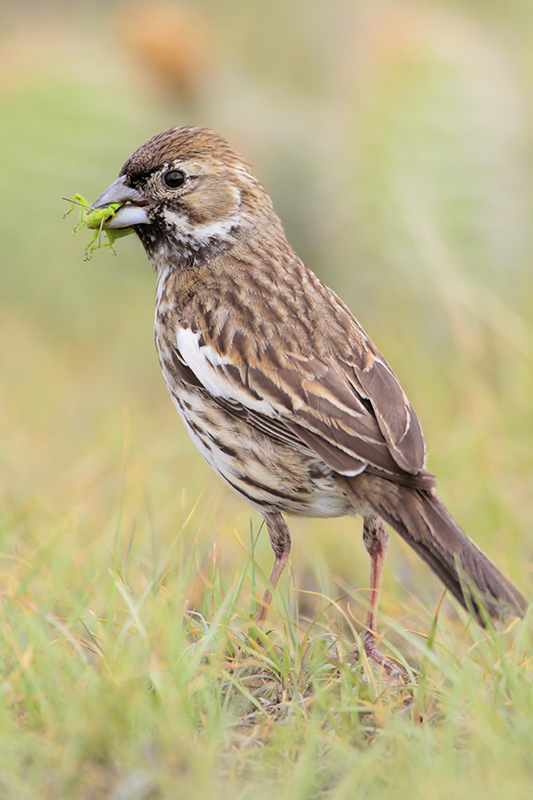
Both sexes have a strong, finch-like bill, fairly long and rounded wings, and a medium-length tail that is black below, has a narrow white tip, and white spots near the end of the undertail. In the spring and summer, male Lark Buntings are black with a grayish bill, a big white patch in the wing, and some small white marks on the undertail.
The female Lark Bunting looks quite different from the male. She is a brownish, sparrow-like bird with a patterned face with a narrow white eyering, a dark cheek bordered by white, some buff above and around the eye, and a dark mustache stripe.
The underparts are white with narrow dark streaks and buff flanks, and the upper parts are brown with dark markings and a small patch of white in the wing.
During the winter months, male Lark Buntings molt into a plumage that resembles the female but is darker, with more black on the face and more white on the wing. No matter what plumage a Lark Bunting may have, in flight, this bird species shows an obvious white patch on the wing and a white tip on the tail.
Call
The most frequent call of the Lark Bunting is a plain but distinctive “hoo-hee” call made by both sexes when birds are flocking together. This species also gives other brief calls when feeding young and in other circumstances but is best known for its complex song.
In spring and early summer, male Lark Buntings sing from perches and in flight to establish territory and attract a mate. They also sing when chasing other males away from their territory.
The song of the male Lark Bunting is a loud, warbling, and trilling melody that carries over the grasslands. It includes several short phrases of trills, warbling notes, and other notes and can be sung from a post or other perch but is usually given after the male flies high into the air.
Behavior
When breeding, Lark Buntings form pairs and defend territories in sagebrush, grassy prairies, and arid plains dotted with cholla cactus. At this time of year, when establishing territories, males often bicker with each other. At other times, this sparrow species is a very social bird that roams grasslands and deserts in Texas, southern Arizona and New Mexico, and northern Mexico.
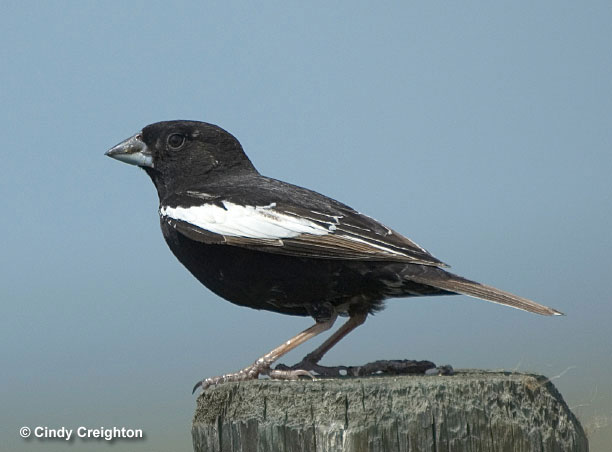
In the winter, large flocks can search for food over a wide area, stopping wherever they find suitable seeding vegetation to feed on. When flocking, they often feed with other sparrow species, quail, and doves.
Lark Buntings are preyed on by a number of animals, including Cooper’s Hawks, falcons, owls, various snakes, and, on occasion, by Loggerhead Shrikes. The eggs and nestlings are especially susceptible and can also be attacked by snakes, ground squirrels, and meadowlarks and other birds.
This species makes alarm calls, dives at potential nest predators, and tries to escape other predators by flocking together for protection.
Lark Buntings can be a bit wary around people and don’t like us approaching their nests. However, they do not fear people very much.
Other Common Birds in Colorado
Although largely overtaken by the Rockies, Colorado has a wide array of bird species. These are some of the most common ones:
- House Finch
- American Robin
- Northern Flicker
- Black-capped Chickadee
- Canada Goose
- Mallard
- Black-billed Magpie
See more: Common Birds of Colorado | Owls in Colorado | Hawks in Colorado
Where Can You See Lark Buntings?
Lark Buntings prefer vegetation, especially grasslands. Although they live in these kinds of habitats, they do not nest in the middle of fields – Lark Buntings usually build their nests at the base of a tree or cactus. During winter, Lark Buntings form groups, often with other bird species.
When it comes to their natural range, Lark Buntings prefer central parts of North America. They breed in most central states, all the way to southern Canada, but winter in Texas, New Mexico, Arizona, and Mexico.
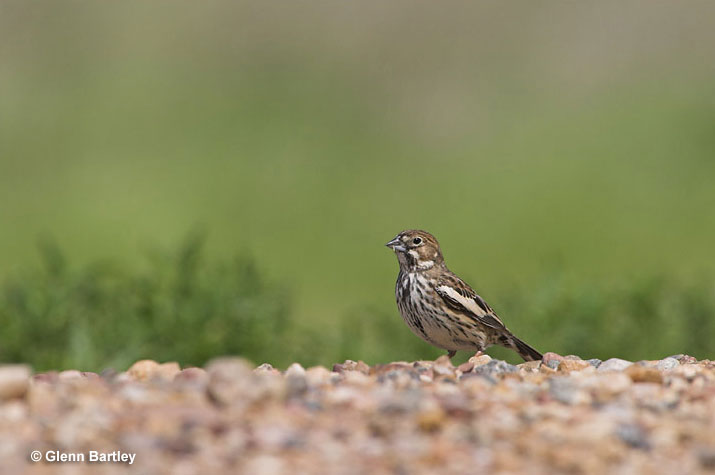
Colorado State Symbols
All states have their own symbols, usually based around their most numerous species or their own subspecies. All in all, these state symbols are in place to do as the name hints – symbolize the state.
As we already gathered, Lark Buntings hold an important value, but here are a few others:
- Amphibian: Western Tiger Salamander
- Cactus: Claret Cup Cactus
- Fish: Greenback Cutthroat Trout
- Flower: Rocky Mountain Columbine
- Grass: Blue Grama Grass
- Insect: Colorado Hairstreak Butterfly
- Mammal: Rocky Mountain Bighorn Sheep
- Reptile: Western Painted Turtle
- Tree: Colorado Blue Spruce

